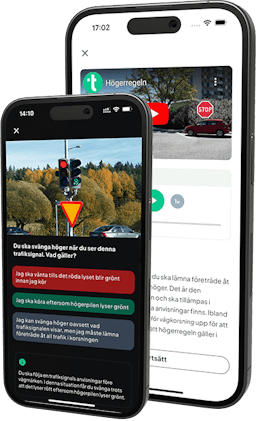Priority-to-the-right Rule
The priority-to-the-right rule means that you must give way to traffic approaching from the right. It is the most common give way rule and applies at junctions where no other instructions apply. Sometimes there is a Junction warning road sign at the junction to show that the priority-to-the-right rule applies there.
The priority-to-the-right rule also applies whenever two vehicles meet in an open area, such as a public square, car park or similar. The rule also applies to cyclists and moped riders.
When does the priority-to-the-right rule not apply?
- At roundabouts.
- In an acceleration lane.
- At junctions with a major road.
- At junctions with functioning traffic lights.
- At junctions with Stop or Give way road signs.
- In places where the exit rule applies; for example when you drive out from a parking space or filling station.
The Give Way Road Sign
In places where there is a Give way road sign, you have a duty to give way to all vehicles on the intersecting road. When approaching the junction, you must slow down in good time to show vehicles on the intersecting road that you have a duty to give way. If there is poor visibility at the junction, you must exercise extra caution.
If you need to stop, stop so that you have good visibility in both directions. If there is a give-way line, you should stop before the line.

Duty to Stop
Where there is a Stop road sign you must stop before entering the road and you have a duty to give way to all vehicles on the intersecting road. Even if there are no other vehicles on the road you intend to enter you must always stop where the duty to stop applies!
Where should I stop?
You should stop just before the stop line. If there is no stop line, or if the stop line is not visible, you should stop immediately before entering the intersecting road.

All-way stop
At certain dangerous junctions, all vehicles have a duty to stop – this is called an all-way stop. The vehicle which first arrives at the junction should also be the first to enter the intersection. Here, it is important to clearly indicate your intentions and try to make eye contact with other drivers in order to avoid misunderstandings.
Major Road
On major roads, other rules apply than the priority-to-the-right rule. If you want to cross a major road, you have a duty to give way to all vehicles on the major road, regardless as to whether they are approaching from the left or the right. This allows traffic on the major road to flow better and prevents disruption by vehicles crossing the major road.

The Turning Rule
The turning rule means that when turning at a junction, you may not obstruct traffic on the road you are turning on to. When turning left at an intersection, you must also swerve for oncoming traffic.
The Exit Rule
The exit rule means that you have a duty to give way when you are crossing or exiting certain areas. The exit rule applies in the following situations:
- When you drive out of a parking space, multi-storey car park, filling station, property or similar.
- When you drive out from a bike path, bicycle street, home zone, pedestrian street, terrain or hard shoulder.
- When you cross a foot path or bike path.
- When you drive out from a narrow road, minor road or similar exit.
The Bus Rule
If you are driving on a road with a speed limit of 50 km/h or lower, you are obliged to give way to busses which indicate that they are driving out from a bus stop. If the road has several lanes, then this rule only applies if you are driving in the right lane. You do not have a duty to give way if the speed limit is 60 km/h or higher.
Whenever you drive past a bus that has stopped at a bus stop, you should always reduce your speed and be prepared to brake. There is a risk that a pedestrian may run out in front of the bus.

The Blocking Rule
The blocking rule means that you must plan your driving and adapt your speed so that you do not need to stop and block crossing traffic at:
- Junctions
- Pedestrian crossings
- Bicycle passages and bicycle crossings
When you are driving in heavy traffic and a queue has formed, you may need to stop several times. It is important to consider the blocking rule in such situations.
Acceleration Lane
Larger roads, such as country roads and motorways, are often equipped with an acceleration lane in order to facilitate entry. Vehicles on the acceleration lane must adapt their speed so that they can drive into a gap without disturbing traffic on the road. Neither vehicles on the road nor vehicles in the acceleration lane have a duty to give way; there is mutual interplay between the two.


